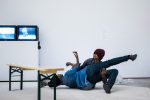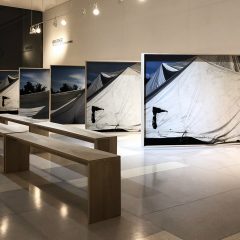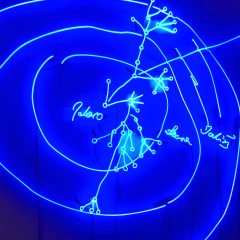Letter from Mari Shaw in Berlin, part 4
This is the last of four posts on Berlin’s Gallery Weekend. Links to the other posts are at the bottom.
Among the exhibitions worth a look in the Hamburger Banhof area is Frontlines: Notations From The Contemporary Indian Urban in the newly opened space by India’s prominent Bodi Gallery, BodhiBerlin. Frontlines is the inaugural show for Bodi’s only gallery in Europe.
YouTube video of Shaheen Merali explaining about Indian art.
The exhibit’s curator, Shaheen Merali, examines what has become a subject of much contemporary art in India, the accelerated urbanization sweeping India cities. A standout work is Atul Dodiya’s Shutter paintings, a project the artist has been working on since 2000. Atul Dodiya uses business security gates–roll-down metal shutters–as his canvases. Dodiya has beautifully painted each of the several shutters in the exhibition as an homage to a different art historical figure.
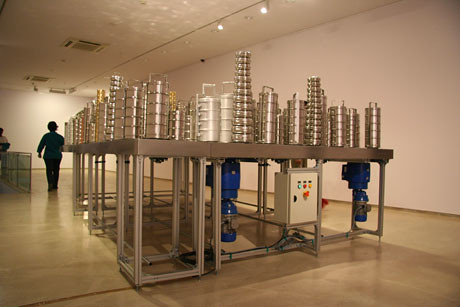
Subodh Gupta, Faith Matters, 2007
Courtesy of the Artist. Picture from Henry Moore Institute
Also on view is Subodh Gupta’s Faith Matters, a dramatic, crowd-pleasing sculpture of a city represented by different-size, rounded metal containers like those tiffin-boxes for Indian hot lunch delivered by enterprising tiffin deliverers in Mumbai. Each of Gupta’s tiffins swirls in circles, capturing the mind-boggling experience of navigating through India’s curving, overcrowded, narrow city streets lined with skyscrapers. It is as though there were a bunch of spinning tops of different dimensions on a table and you spun all of them simultaneously.
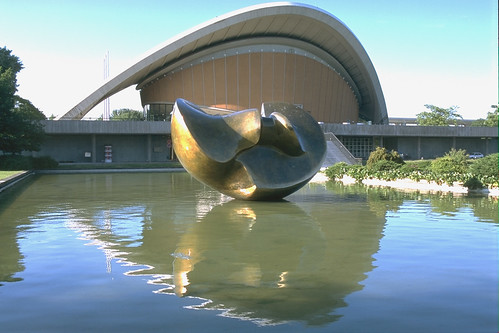
House of World Cultures, photo courtesy of the institution.
Mirali also curated an exhibition of some wonderful works at the House of World Cultures, a museum/cultural center that was a gift to Berlin from America during the Carter Administration. The front of the building has an architectural embellishment that looks like an abstracted toothy grin. The Berliners affectionately call the building Jimmy Carter’s Smile.
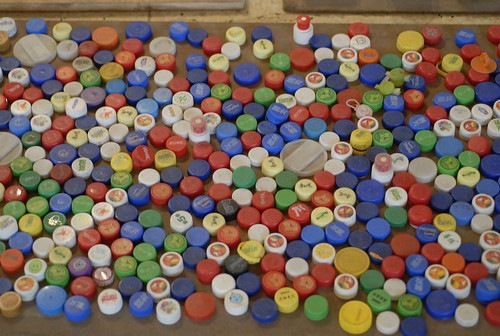
Song Dong and Zhao Xiangyuan, Waste Not, detail. Photo by Jochen Schmidt.
In China, many families save all their possessions from used clothes to empty bottles to plastic bags to everything in between. The families, like Artist Song Dong’s family, believe that every object, no matter how damaged, no matter how humble, will have a future use.
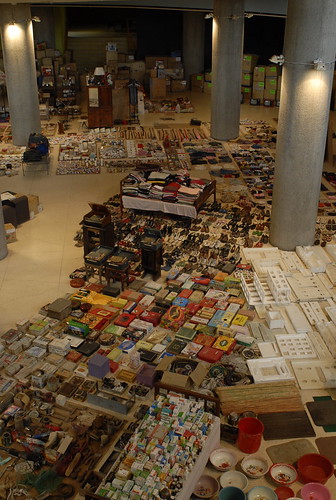
Song Dong and Zhao Xiangyuan, Waste Not, detail. Photo by Jochen Schmidt.
For this ambitious installation, the artists arranged for the transport by truck of every one of the thousands of saved objects in Song Dong’s mother’s house giving them a second use as art. The artists arranged the objects across the entire ground floor of the museum every bit as artfully as an installation by Jason Rhoads.
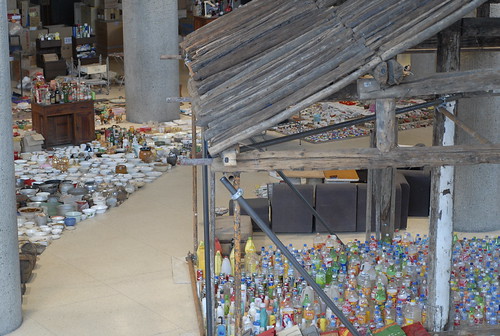
Song Dong and Zhao Xiangyuan, detail. Photo by Jochen Schmidt.
The artists completed the installation during the opening, talking to viewers as they worked and listening to their suggestions, a happy cooperation among viewers and the artists. The visual impact is a knock out.
Re-imagining Asia has animation and theater components. I had an authentic and transfixing experience there at a three-hour performance by the Kabuki Theater from Tokyo. This is the first time the Kabuki Theater has come to Europe. The story, written in 1745, deals with the system of honor in Japanese society and the ridiculous and tragic havoc caused in the name of maintaining one’s honor.
As it works through its complicated plot, the tale deals with a host of human issues: oedipal conflict, romantic love, carnal love, fidelity, self discipline, the folly of impetuous behavior, power and corruption, to name just a few. The range of entertainments is impressive, from precise and powerful dance to bawdy joking, slapstick and trickster humor, to high drama and tragedy, to satire and political critique.
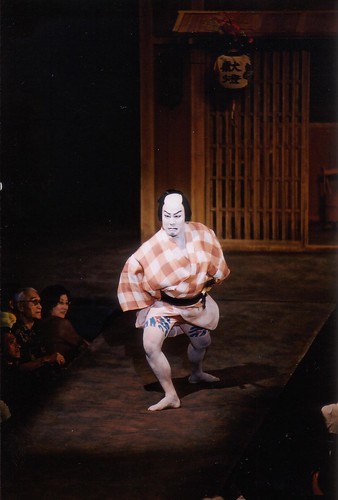
Kabuki 1
© Heisei Nakamura-za
Courtesy of House of World Cultures
The low-tech production was extraordinarily effective. Rapidly moving hand held lights fanned the stage during certain scenes, creating an ominous backdrop. One of the most artful scenes begins with a son-in-law confronting his despicable, cruel father-in-law who has dishonored the son-in-law. The son-in-law, not an entirely virtuous person himself, tricks his father-in-law into helping him regain his honor by promising the father-in-law gold. When the son-in-law does not pay up, the father-in-law maliciously thrusts the ultimate dishonor on his son-in-law, calling him, within earshot of others, a father-murderer, the vilest type of criminal in Japanese culture. The distraught son-in-law, who has a problem with self-control in even the best of circumstances, kills his father-in-law in one of the most famous and violent murder scenes in Kabuki Theater. The color, the tense body movements, the lights, the frantic Macbeth like hand washing to cleanse the indelible bloodstains, and the foreboding music are spellbinding.
The musical star of the Kabuki production is a skillful, athletic young drummer who, with his beautiful bare back to the audience, gongs booming sounds with sweeping movements of his strong arms, sounds which crescendo at highly dramatic moments with brutal intensity.
Visually, the performance is beautiful. Across the top of the theater are characteristic Japanese paintings of some of the scenes from the Kabuki performance, the kind of paintings which had previously left me cold. In the context of watching the performance, however, these paintings of frozen Kabuki scenes made sense. The focus of the visual beauty though is on the stage and in the aisles as the costumed actors run and pose. The leg, arm and neck movements of the actors in their colorful costumes were the real, exhilarating paintings.



